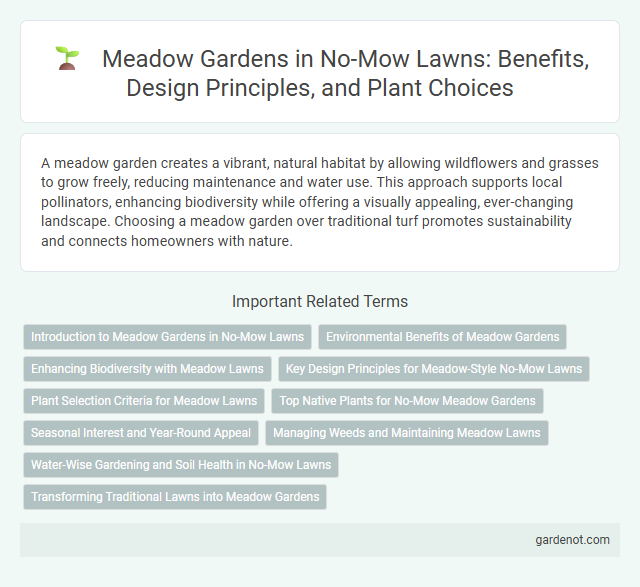A meadow garden creates a vibrant, natural habitat by allowing wildflowers and grasses to grow freely, reducing maintenance and water use. This approach supports local pollinators, enhancing biodiversity while offering a visually appealing, ever-changing landscape. Choosing a meadow garden over traditional turf promotes sustainability and connects homeowners with nature.
Introduction to Meadow Gardens in No-Mow Lawns
Meadow gardens in no-mow lawns create biodiverse, low-maintenance landscapes by incorporating native wildflowers and grasses that support pollinators and local wildlife. These gardens promote soil health and reduce water usage by mimicking natural ecosystems, fostering sustainability in urban and suburban settings. Integrating a meadow garden enhances the aesthetic appeal with seasonal blooms while eliminating the need for frequent mowing and chemical treatments.
Environmental Benefits of Meadow Gardens
Meadow gardens significantly enhance biodiversity by providing habitats for pollinators, birds, and beneficial insects. They improve soil health and water retention, reducing erosion and the need for irrigation. Maintaining a no-mow meadow garden lowers carbon emissions by eliminating gas-powered mower use, promoting a sustainable and eco-friendly lawn alternative.
Enhancing Biodiversity with Meadow Lawns
Meadow lawns significantly enhance biodiversity by providing essential habitats for pollinators such as bees, butterflies, and other beneficial insects. The diverse mix of native grasses and wildflowers supports a wider range of soil microorganisms and wildlife compared to traditional turfgrass. This low-maintenance approach promotes ecological balance, conserves water, and reduces the need for chemical fertilizers and pesticides.
Key Design Principles for Meadow-Style No-Mow Lawns
Meadow-style no-mow lawns emphasize native wildflowers and grasses to create a biodiverse, low-maintenance landscape that supports pollinators and wildlife. Key design principles include selecting regionally appropriate plants with staggered bloom times to ensure year-round visual interest and habitat stability. Incorporating varied plant heights and textures mimics natural ecosystems, reducing the need for frequent mowing and promoting ecological balance.
Plant Selection Criteria for Meadow Lawns
Plant selection for meadow lawns prioritizes native, drought-tolerant species that promote biodiversity and require minimal maintenance. Deep-rooted grasses and wildflowers such as fescues, clovers, and oxeye daisies enhance soil health and attract pollinators like bees and butterflies. Choosing a diverse mix of perennials ensures seasonal color variation and resilience against pests and diseases.
Top Native Plants for No-Mow Meadow Gardens
Top native plants for no-mow meadow gardens include purple coneflower (Echinacea purpurea), black-eyed Susan (Rudbeckia hirta), and little bluestem (Schizachyrium scoparium). These species provide excellent habitat for pollinators, require minimal maintenance, and adapt well to local soil conditions. Incorporating a diverse mix of native grasses and wildflowers ensures year-round color and supports ecological balance in sustainable lawn alternatives.
Seasonal Interest and Year-Round Appeal
Meadow gardens offer a dynamic display of seasonal interest with diverse wildflowers and grasses that bloom from spring through fall, attracting pollinators and enhancing biodiversity. Their naturalistic appeal provides vibrant color and texture shifts throughout the year, from fresh green shoots in spring to golden seed heads in winter. This year-round variation creates a sustainable, low-maintenance landscape that remains visually engaging in every season.
Managing Weeds and Maintaining Meadow Lawns
Meadow lawns require strategic weed management through selective mowing and targeted spot treatments to preserve native wildflowers and grasses. Maintaining meadow gardens involves seasonal mowing schedules that prevent invasive species from dominating while encouraging biodiversity and soil health. Proper irrigation and nutrient management support resilient meadow ecosystems that thrive with minimal intervention.
Water-Wise Gardening and Soil Health in No-Mow Lawns
Meadow gardens in no-mow lawns enhance water-wise gardening by reducing irrigation needs through deep-rooted native grasses and drought-tolerant plants that retain soil moisture. These landscapes improve soil health by minimizing disturbance, promoting organic matter buildup, and supporting beneficial microbial activity. Implementing native species in meadows encourages biodiversity while maintaining sustainable water use and robust soil ecosystems.
Transforming Traditional Lawns into Meadow Gardens
Transforming traditional lawns into meadow gardens enhances biodiversity by supporting native wildflowers and pollinators such as bees and butterflies. This no-mow approach reduces maintenance costs and water usage while promoting healthier soil ecosystems. Meadow gardens create vibrant, natural habitats that improve urban green spaces and contribute to environmental sustainability.
Meadow garden Infographic

 gardenot.com
gardenot.com